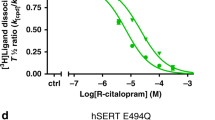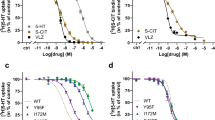Abstract
Antidepressants are commonly supposed to enhance serotonergic and/or noradrenergic neurotransmission by inhibition of neurotransmitter reuptake through binding to the respective neurotransmitter transporters or through inhibition of the monoamine oxidase. Using the concentration-clamp technique and measurements of intracellular Ca2+, we demonstrate that different classes of antidepressants act as functional antagonists at the human 5-HT3A receptor stably expressed in HEK 293 cells and at endogenous 5-HT3 receptors of rat hippocampal neurons and N1E-115 neuroblastoma cells. The tricyclic antidepressants desipramine, imipramine, and trimipramine, the serotonin reuptake inhibitor fluoxetine, the norepinephrine reuptake inhibitor reboxetine, and the noradrenergic and specific serotonergic antidepressant mirtazapine effectively reduced the serotonin-induced Na+- and Ca2+-currents in a dose-dependent fashion. This effect was voltage-independent and, with the exception of mirtazapine, noncompetitive. Desipramine, imipramine, trimipramine, and fluoxetine also accelerated receptor desensitization. Moclobemide and carbamazepine had no effect on the serotonin-induced cation current. By analyzing analogues of desipramine and carbamazepine, we found that a basic propylamine side chain increases the antagonistic potency of tricyclic compounds, whereas it is abolished by an uncharged carboxamide group. The antagonistic effects of antidepressants at the 5-HT3 receptor did not correlate with their effects on membrane fluidity. In conclusion, structurally different types of antidepressants modulate the function of this ligand-gated ion channel. This may represent a yet unrecognized pharmacological principle of antidepressants.
This is a preview of subscription content, access via your institution
Access options
Subscribe to this journal
Receive 12 print issues and online access
$259.00 per year
only $21.58 per issue
Buy this article
- Purchase on Springer Link
- Instant access to full article PDF
Prices may be subject to local taxes which are calculated during checkout








Similar content being viewed by others
References
Pacher P, Kohegyi E, Kecskemeti V, Frust S . Current trends in the development of new antidepressants. Curr Med Chem 2001; 8: 89–100.
Blakely RD . Physiological genomics of antidepressant targets: keeping the periphery in mind. J Neurosci 2001; 21: 8319–8323.
Duman RS, Heninger GR, Nestler EJ . A molecular and cellular theory of depression. Arch Gen Psychiatry 1997; 54: 597–606.
Holsboer F, Barden N . Antidepressants and hypothalamic pituitary adrenocortical regulation. Endocrine Rev 1996; 17: 187–205.
Kent JM . SNaRIs, NaSSAs, and NaRIs: new agents for the treatment of depression. Lancet 2000; 355: 911–918.
Frazer A . Serotonergic and noradrenergic reuptake inhibitors: prediction of clinical effects from in vitro potencies. J Clin Psychiatry 2001; 62: 16–23.
Fan P . Inhibition of a 5-HT3 receptor-mediated current by the selective serotonin uptake inhibitor, fluoxetine. Neurosci Lett 1994; 173: 210–212.
Breitinger H-GA, Geetha N, Hess GP . Inhibition of the serotonin 5-HT3 receptor by nicotine, cocaine, and fluoxetine investigated by rapid chemical kinetic techniques. Biochemistry 2001; 40: 8419–8429.
Maricq AV, Peterson AS, Brake AJ, Myers RM, Julius D . Primary structure and functional expression of the 5HT3 receptor, a serotonin-gated ion channel. Science 1991; 254: 432–437.
Davies PA, Pistis M, Hanna MC, Peters JA, Lambert JJ, Hales TG et al. The 5-HT3B subunit is a major determinant of serotonin-receptor function. Nature 1999; 397: 359–363.
Dubin AE, Huvar R, D'Andrea MR, Pyati J, Zju JY, Joy KC et al. The pharmacological and functional characteristics of the serotonin 5-HT3 receptor are specifically modified by a 5-HT3B receptor subunit. J Biol Chem 1999; 274: 30799–30810.
Kilpatrick GJ, Jones BJ, Tyers MB . Identification and distribution of 5-HT3 receptor, a serotonin-gated ion channel. Nature 1987; 330: 746–748.
Tecott LH, Maricq AV, Julius D . Nervous system distribution of the 5-HT3 receptor in rat brain using radioligand binding. Proc Natl Acad Sci USA 1993; 90: 1430–1443.
Sugita S, Shen KZ, North RA . 5-Hydroxytryptamine is a fast excitatory transmitter at 5-HT3 receptors in rat amygdala. Neuron 1992; 8: 199–203.
Gralla RJ, Hri LMPSE, Squillant AE, Kelsen DP, Braun DW, Bordin LA et al. Antiemetic efficacy of high dose metoclopramide: randomized trials with placebo and prochlorperazine in patients with chemotherapy-induced nausea and vomiting. N Engl J Med 1991; 305: 905–909.
Kazemi-Kjellberg F, Henzi I, Tramer M . Treatment of established postoperative nausea and vomiting: a quantitative systematic review. BMC Anesthesiol 2001; 1: 2.
Ye JH, Ponnudurai R, Schaefer R . Ondansetron: a selective 5-HT3 receptor antagonist and its applications in CNS-related disorders. CNS Drug Rev 2001; 7: 199–213.
Rodgers RJ, Cole JC, Tredwell JM . Profile of action of 5-HT3 receptor antagonists, ondansetron and WAY 100289, in the elevated plus-maze test of anxiety of mice. Psychopharmacology 1995; 117: 306–312.
Nakagawa Y, Ishima T, Takashima T . The 5-HT3 receptor agonist attenuates the action of antidepressants in the forced swim test in rats. Brain Res 1998; 786: 189–193.
Greenshaw AJ, Silverstone PH . The non-antiemetic uses of serotonin 5-HT3 receptor antagonists. Drugs 1997; 53: 20–39.
Warburton AC, Cole JC, Tredwell JM . Antagonism of amphetamine-induced disruption of latent inhibition in rats by haloperidol and ondansetron: implications for a possible antipsychotic action of ondansetron. Psychopharmacology 1994; 114: 657–664.
Zoldan J, Friedberg G, Goldberg-Stern H, Melamed E . Ondansetron for hallucinosis in advanced Parkinson's disease. Lancet 1993; 341: 562–563.
Wetzel CHR, Hermann B, Behl C, Pestel E, Rammes G, Ziegelgänsberger W et al. Functional antagonism of gonadal steroids at the 5-hydroxytryptamine type 3 receptor. Mol Endocrinol 1998; 12: 1441–1451.
Lambert JJ, Belelli D, Hill-Venning D, Peters J . Neurosteroids and GABAA receptor function. Trends Pharmacol Sci 1995; 16: 295–303.
Rupprecht R, Holsboer F . Neuroactive steroids: mechanisms of action and neuropsychopharmacological perspectives. Trends Neurosci 1999; 22: 410–416.
Lankiewicz S, Lobitz N, Wetzel CHR, Rupprecht R, Gisselmann G, Hatt H . Molecular cloning, functional expression, and pharmacological characterization of 5-hydroxytryptamine3 receptor cDNA and its splice variants from guinea pig. Mol Pharmacol 1998; 53: 202–212.
Bondy B, Klages U, Müller-Spahn F, Hock C . Cytosolic free [Ca2+] in mononuclear blood cells from demented patients and healthy controls. Eur Arch Psychiatry Clin Neurosci 1994; 243: 224–228.
Munson PJ, Rodbard D . LIGAND: a versatile computerized approach for characterization of ligand-binding systems. Anal Biochem 1980; 107: 263–270.
Gimpl G, Fahrenholz F . Human oxytocin receptors in cholesterol-rich vs. cholesterol-poor microdomains of the plasma membrane. Eur J Biochem 2000; 267: 2483–2497.
Fan P . Effects of antidepressants on the inward current mediated by 5-HT3 receptors in rat nodose ganglion neurones. Br J Pharmacol 1994; 112: 741–744.
Bufler J, Wilhelm R, Parnas H, Franke C, Dudel J . Open channel and competitive block of the embryonic form of the nicotinic receptor of mouse myotubes by (+)-tubocurarine. J Physiol 1996; 495: 83–95.
Rammes G, Rupprecht R, Ferrari U, Zieglgänsberger W, Parsons CG . The N-methyl-D-aspartate receptor channel blockers memantine, MRZ 2/579 and other amino-alkyl-cyclohexanes antagonise 5-HT3 receptor currents in cultured HEK-293 and N1E-115 cell systems in a non-competitive manner. Neurosci Lett 2001; 306: 81–84.
Brown AM, Hope AG, Lambert JJ, Peters JA . Ion permeation and conduction in a human recombinant 5-HT3 receptor subunit (h5-HT3A). J Physiol 1998; 507: 653–665.
Bliss AVP, Collingridge GL . A synaptic model of memory–long-term potentiation in the hippocampus. Nature 1993; 361: 31–39.
Hargreaves AC, Lummis SCR, Taylor CW . Ca2+ permeability of cloned and native 5-hydroxytryptamine type 3 receptors. Mol Pharmacol 1994; 46: 1120–1128.
Wilson GG, Karlin A . The location of the gate in the acetylcholine receptor channel. Neuron 1998; 20: 1269–1281.
Bertrand D, Galzi JL, Devillers-Thiery A, Bertrand S, Changeux JP . Mutations at two distinct sites within the channel domain M2 alter calcium permeability of neuronal A7 nicotinic receptor. Neurobiology 1993; 90: 6971–6975.
Carfagna MA, Muhoberac BB . Interaction of tricyclic drug analogs with synaptic plasma membranes: structure–mechanism relationships in inhibition of neuronal Na+/K+-ATPase activity. Mol Pharmacol 1993; 44: 129–141.
Melzacka M, Nocon H . Effect of imipramine on the membrane anisotropy and on the phospholipid methylation in the central nervous system of the rat. J Pharm Pharmacol 1990; 43: 564–568.
Lejoyeux M, Daveloose D, Mazière JC, Adès J, Viret J . A spin label study of the membrane effect of various psychoactive drugs in human erythrocytes. Life Sci 1992; 52: PL-7–PL-11.
Sanganahalli BG, Joshi PG, Joshi NB . Differential effects of tricyclic antidepressant drugs on membrane dynamics—a fluorescence spectroscopic study. Life Sci 2000; 68: 81–90.
Blanton MP, Xie Y, Dangott LJ, Cohen JB . The steroid promegestone is a noncompetitive antagonist of the Torpedo nicotinic acetylcholine receptor that interacts with the lipid–protein interface. Mol Pharmacol 1999; 55: 269–278.
Barrantes FJ, Antollini SS, Bouzat C, Garbus I, Massol RH . Nongenomic effects of steroids on the nicotinic acetylcholine receptor. Kidney Int 2000; 57: 1382–1389.
Weigmann H, Härtter S, Bagli M, Hiemke C . Steady state concentrations of clomipramine and its major metabolite desmethylclomipramine in rat brain and serum after oral administration of clomipramine. Eur Neuropsychopharmacol 2000; 10: 401–405.
Uhr M, Steckler T, Yassouridis A, Holsboer F . Penetration of amitriptyline, but not of fluoxetine, into brain is enhanced in mice with blood–brain barrier deficiency due to Mdr1a P-glycoprotein gene disruption. Neuropsychopharmacology 2000; 22: 380–387.
Bolo NR, Hodé Y, Nédélec JF, Lainé E, Wagner G, Macher JP . Brain pharmacokinetics and tissue distribution in vivo of fluvoxamine and fluoxetine by fluorine magnetic resonance spectroscopy. Neuropsychopharmacology 2000; 23: 428–438.
Henry ME, Moore C, Kaufmann M, Michelson D, Schmidt M, Stoddard E et al. Brain kinetics of paroxetine and fluoxetine on the third day of placebo substitution: a fluorine MRS study. Am J Psychiatry 2000; 157: 1506–1508.
Acknowledgements
We thank Iris Bauer, Sonja Wirth, Christiane Rewerts, Sabrina Meyr, and Sylvia de Jonge for their expert technical assistance. This work was supported by a Tandem Project of the Max-Planck-Society and the German Ministry for Education and Research within the promotional emphasis ‘German Research Network on depression’ (Subproject 4.3).
Author information
Authors and Affiliations
Corresponding author
Rights and permissions
About this article
Cite this article
Eisensamer, B., Rammes, G., Gimpl, G. et al. Antidepressants are functional antagonists at the serotonin type 3 (5-HT3) receptor. Mol Psychiatry 8, 994–1007 (2003). https://doi.org/10.1038/sj.mp.4001314
Received:
Revised:
Accepted:
Published:
Issue Date:
DOI: https://doi.org/10.1038/sj.mp.4001314
Keywords
This article is cited by
-
Selective 5HT3 antagonists and sensory processing: a systematic review
Neuropsychopharmacology (2022)
-
Multi-modal antidepressant-like action of 6- and 7-chloro-2-aminodihydroquinazolines in the mouse tail suspension test
Psychopharmacology (2019)
-
Molecular basis of atypicality of bupropion inferred from its receptor engagement in nervous system tissues
Psychopharmacology (2018)
-
Single Administration of HBK-15—a Triple 5-HT1A, 5-HT7, and 5-HT3 Receptor Antagonist—Reverses Depressive-Like Behaviors in Mouse Model of Depression Induced by Corticosterone
Molecular Neurobiology (2017)
-
Paroxetine suppresses recombinant human P2X7 responses
Purinergic Signalling (2015)



